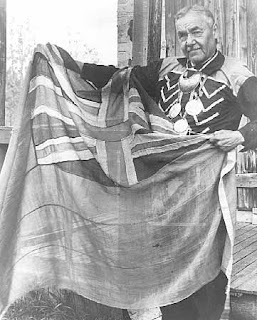You cannot escape it. When we discuss objects and artifacts in collections we must talk provenance. If the object does not hold a "pedigree", it casts doubt as to whether that object is genuine. Hence, objects with good provenance are so valuable, not just monetarily, but in historic significance. Some artifacts are simply so old, that even if the story attached to them cannot be verified, the age of the piece places it close enough to a significant person or moment in time that the piece therefore gains importance.
 |
| Tecumseh Flag, NMAI. |
This particular flag has nice provenance and it is in remarkable shape. It is made of wool bunting and hand-stitched with linen thread. Along the hoist are three hand-stitched grommets.
 |
| Tecumseh (1768 - October 1813) a Shawnee leader. |
The answer is multi-layered. First, is that it is the custom of the British to present flags, medals or uniforms to Indian chiefs as an understanding of their relationship and the expectation that the Indians will fight for the British. Many of these flags were referred to as "treaty flags", but there is often an absence of a formal treaty, so perhaps they are best described as "gift flags"? Tecumseh was aligned with the British through Major-General Sir Isaac Brock, in hopes of creating or maintaining an independent Indian state in the Midwest. Tecumseh came to the aid of the British in the capture of Fort Detroit. But, during the Battle of the Thames in 1813, he was killed. After his death, his confederation fell apart and the British deserted their Indian allies at the peace conference that ended the War of 1812. Later, American settlers took possession of all the territory south of the Great Lakes.
 |
| Northern Indiana |
With that bit of history, let us look back to the large number of flags that are associated with Tecumseh and their similarities and differences. A British red ensign flag is at the Windsor Museum in Canada, also called the Tecumseh Flag. This flag is said to have covered the body of Tecumseh following his death at the Battle of Thames and has an oral history associated with it. So while the colors are correct for the time period, the story that accompanies it, can never be confirmed. The red background is somewhat a mystery in that a red ensign was designated as a merchant ensign, whereas the blue was a Naval Reserve ensign.
 |
| Tecumseh Flag, Windsor's Community Museum, ca 1960s. |
 |
| Windsor Community Museum's Tecumseh Flag. (June 2012) |
The construction and the size of both the NMAI's and Windsor's flags are similar. But one is blue and the other is red. Two other similar flags are found at the Kentucky and Minnesota Historical Societies, respectively. The color differences and their relationship to Tecumseh is a mystery. Are they simply legends perpetuating more intrigue? Or in fact, part of symbolic alliances between parties? Tecumseh's death at the Battle of the Thames marked the end of his resistance movement and the start of a period of myth-making that would craft an imagined hero out of this extraordinary man.
 |
| Records indicate that the "flag was carried by Native Americans who fought with Tecumseh during the War of 1812" (Kentucky Historical Society) |
 |
| Ojibwa
Chief Mike Flatte in a ca.
1930 photograph wearing British treaty medals and holding the flag. (Minnesota Historical Society) |
Maybe we are thinking of this in too narrow terms. Perhaps the color is not what is important, perhaps the symbolism of giving a flag is what mattered and the kind of flag, or where it came from was not considered. Additionally, how many flags were available to give? Maybe you gave whatever you had on hand?
The major European powers in North America are known to have executed various treaties with the Native American Indians, namely Great Britain, France, Spain, Russia and later their respective successors in interest Canada, United States and Mexico. The execution of these treaties was often accompanied with the exchange of gifts. The Indians often gave pelts, tanned skins, intricate beadwork and other crafts while their European counterparts often presented chiefs with medals, uniforms and flags.
The United States and
Canada are all known to have continued the practice well into the 19th
century.
In the case of Great
Britain, the flag most often gifted to the Indians
were red or blue ensigns. Clearly flags were not just given to Tecumseh but to other Chiefs as well who the government wanted to have favor with.
To read more about Tecumseh and some of the other artifacts associated with him go to: http: //tecumseh.omeka.net/exhibits/show/traces-of--shooting-star---the/introduction and http://blog.nmai.si.edu/main/2012/11/a-flag-of-the-fathers.html
Special thanks to Vexologists, James Ferrigan, David Martucci and David Phillips for sharing their wealth of knowledge about all things flag related.
Special thanks to Vexologists, James Ferrigan, David Martucci and David Phillips for sharing their wealth of knowledge about all things flag related.
"The red background is somewhat a mystery in that a red ensign was designated as a merchant ensign, whereas the blue was a Naval Reserve ensign". The flag color at the time still represented which Admiral and squadron was in charge. Colors representing Merchant Class and Naval Reserve did not come into effect until 1864.
ReplyDelete